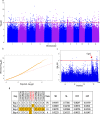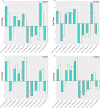Linkage analysis, GWAS, transcriptome analysis to identify candidate genes for rice seedlings in response to high temperature stress
- PMID: 33563229
- PMCID: PMC7874481
- DOI: 10.1186/s12870-021-02857-2
Linkage analysis, GWAS, transcriptome analysis to identify candidate genes for rice seedlings in response to high temperature stress
Abstract
Background: Rice plants suffer from the rising temperature which is becoming more and more prominent. Mining heat-resistant genes and applying them to rice breeding is a feasible and effective way to solve the problem.
Result: Three main biomass traits, including shoot length, dry weight, and fresh weight, changed after abnormally high-temperature treatment in the rice seedling stage of a recombinant inbred lines and the natural indica germplasm population. Based on a comparison of the results of linkage analysis and genome-wide association analysis, two loci with lengths of 57 kb and 69 kb in qDW7 and qFW6, respectively, were associated with the rice response to abnormally high temperatures at the seedling stage. Meanwhile, based on integrated transcriptome analysis, some genes are considered as important candidate genes. Combining with known genes and analysis of homologous genes, it was found that there are eight genes in candidate intervals that need to be focused on in subsequent research.
Conclusions: The results indicated several relevant loci, which would help researchers to further discover beneficial heat-resistant genes that can be applied to rice heat-resistant breeding.
Keywords: GWAS; High-temperature-mediated growth response; Linkage analysis; Rice seedling; Transcriptome analysis.
Conflict of interest statement
The authors declare that they have no competing interests.
Figures







Similar articles
-
Uncovering novel loci for mesocotyl elongation and shoot length in indica rice through genome-wide association mapping.Planta. 2016 Mar;243(3):645-57. doi: 10.1007/s00425-015-2434-x. Epub 2015 Nov 26. Planta. 2016. PMID: 26612069 Free PMC article.
-
Genome-Wide Association Study of Root System Development at Seedling Stage in Rice.Genes (Basel). 2020 Nov 25;11(12):1395. doi: 10.3390/genes11121395. Genes (Basel). 2020. PMID: 33255557 Free PMC article.
-
Candidate genes for alkali tolerance identified by genome-wide association study at the seedling stage in rice (Oryza sativa L.).Sci Rep. 2024 Dec 3;14(1):30063. doi: 10.1038/s41598-024-79273-7. Sci Rep. 2024. PMID: 39627306 Free PMC article.
-
Genetic variation and association mapping for 12 agronomic traits in indica rice.BMC Genomics. 2015 Dec 16;16:1067. doi: 10.1186/s12864-015-2245-2. BMC Genomics. 2015. PMID: 26673149 Free PMC article.
-
High temperature-mediated disturbance of carbohydrate metabolism and gene expressional regulation in rice: a review.Plant Signal Behav. 2021 Mar 4;16(3):1862564. doi: 10.1080/15592324.2020.1862564. Epub 2021 Jan 20. Plant Signal Behav. 2021. PMID: 33470154 Free PMC article. Review.
Cited by
-
GWAS combined with transcriptomics revealed key regulatory genes for inflorescence traits and fruit set rate in Litchi (Litchi chinensis Sonn.).BMC Genomics. 2025 Jul 26;26(1):692. doi: 10.1186/s12864-025-11796-3. BMC Genomics. 2025. PMID: 40713492 Free PMC article.
-
RNA-Seq and Genome-Wide Association Studies Reveal Potential Genes for Rice Seed Shattering.Int J Mol Sci. 2022 Nov 23;23(23):14633. doi: 10.3390/ijms232314633. Int J Mol Sci. 2022. PMID: 36498964 Free PMC article.
-
Uncovering novel genes for drought stress in rice at germination stage using genome wide association study.Front Plant Sci. 2024 Aug 1;15:1421267. doi: 10.3389/fpls.2024.1421267. eCollection 2024. Front Plant Sci. 2024. PMID: 39148613 Free PMC article.
-
Combining GWAS, Genome-Wide Domestication and a Transcriptomic Analysis Reveals the Loci and Natural Alleles of Salt Tolerance in Rice (Oryza sativa L.).Front Plant Sci. 2022 Jun 16;13:912637. doi: 10.3389/fpls.2022.912637. eCollection 2022. Front Plant Sci. 2022. PMID: 35783926 Free PMC article.
-
QTL Mapping and Genome-Wide Association Study Reveal Genetic Loci and Candidate Genes Related to Soluble Solids Content in Melon.Curr Issues Mol Biol. 2023 Aug 26;45(9):7110-7129. doi: 10.3390/cimb45090450. Curr Issues Mol Biol. 2023. PMID: 37754234 Free PMC article.
References
-
- Akman Z. Comparison of high temperature tolerance in maize, rice and sorghum seeds by plant growth regulators [J] J Anim Vet Adv. 2009;8(2):358–361.
Publication types
MeSH terms
Grants and funding
- KQTD2016113010482651/Shenzhen Science and Technology Program
- RC201901-05/Projects Subsidized by Special Funds for Science Technology Innovation and Industrial Development of Shenzhen Dapeng New District
- 2019A1515110557/Guangdong Basic and Applied Basic Research Foundation
- 2020M672903/China Postdoctoral Science Foundation
LinkOut - more resources
Full Text Sources
Other Literature Sources

